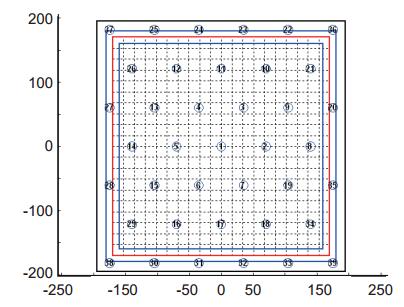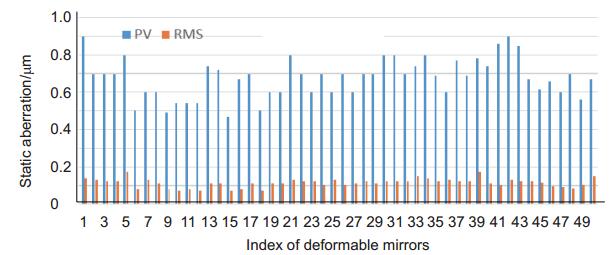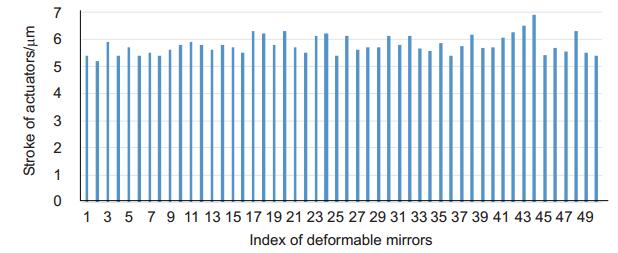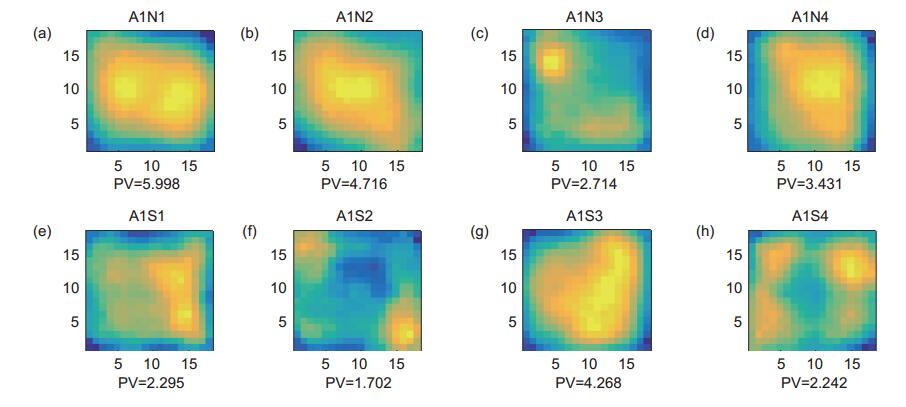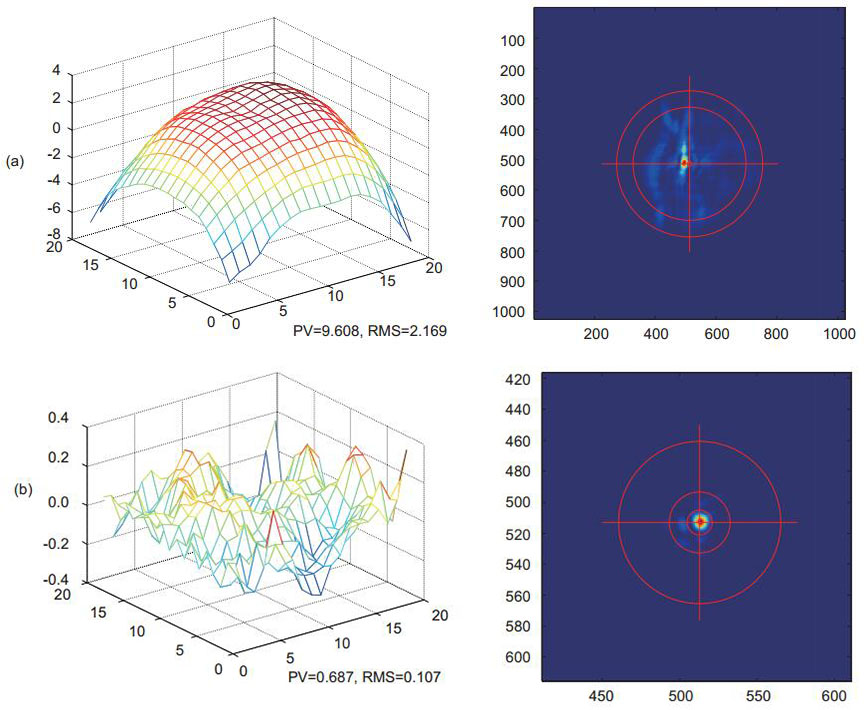-
摘要
本文介绍了为“神光-Ⅲ”主机装置研制的五十套工程化自适应光学系统,包括系统技术方案,基于可拆卸技术的大口径变形镜和具有自动对准功能的哈特曼波前传感器两主要部件的性能,测量并分析了波前特性,系统校正结果表明:自适应光学系统改善了主机装置的光束质量,满足10倍衍射极限范围内激光能量大于95%的指标要求,确保“神光-Ⅲ”主机装置激光在主放大系统内的传输顺畅。
Abstract
The fifty engineered-manufacture adaptive optics systems developed for the Shen Guang Ⅲ (SGⅢ) facility, are introduced in this paper. The system technical scheme, together with the key components – the dismountable large aperture deformed mirror and the auto-alignment Shack-Hartmann wavefront sensor, are presented. The characteristic of the wavefront is measured and analyzed. The result of system correction shows that the adaptive optics systems improved the beam quantity of the SGⅢ facility, meet the requirement that the laser beam energy is higher than 95% in the 10-time diffraction limit zone, and ensured the laser transmission in the main amplification system of the SGⅢ facility.
-
Key words:
- Shen Guang Ⅲ (SGⅢ) facility /
- adaptive optics /
- wavefront correction
-
Overview

Overview: The aberration in the inertial confinement fusion (ICF) system degrades the quality of high-power laser beam, bringing about problems such as decreasing of the laser focusing characteristic, blocking the plasma hole and decreasing of efficiency of the frequency tripling. The adaptive optics (AO) has been proved to be the key approach to solve the aberration problem in ICF, with its successful applications in the National Ignition Facility (NIF), OMEGA EP and Shen Guang I facility. This paper reports the fifty suites of engineered-manufacture adaptive optics systems developed for the Shen Guang Ⅲ (SGⅢ) facility.
The system structure of SGⅢ is briefly described first. Each AO system of SGⅢ consists of a high-accuracy-controll-ability and high-damage-threshold large aperture reflective dismountable deformable mirror and a Shack-Hartmann wavefront sensor. The deformable mirror is composed of 39 PZT actuators with dynamic range of ±5 μm. Its maximum and working apertures are 360 mm×360 mm and 320 mm×320 mm, respectively. The Shack-Hartmann wavefront sensor uses a micro-lens array of 22×22 with 484 efficient sub-apertures in the 6 mm×6 mm square aperture. Its dynamic range is more than 15 μm and its accuracy (RMS) is higher than 0.1 μm.
The deformable mirror is designed to meet the system requirement that PV and RMS of the residual wavefront are less than 1 μm and 0.2 μm, respectively, for the correction of the aberration of Zernike mode (±4 μm@1-10, ±1 μm@11-15). PV and RMS of the original surface and the dynamic range of the 50 suites of deformable mirrors are tested. The micro-deformation of the actuators after charging is also investigated.
The Shack-Hartmann wavefront sensor module consists of a Shack-Hartmann wavefront sensor, an electrical attenuator and a four-axis auto-align adjusting rack. The electrical attenuator adjusts the power of the incident laser beam to the working range of the Shack-Hartmann wavefront sensor. The four-axis auto-align adjusting rack aligns the Shack-Hartmann wavefront sensor to the incident laser beam. The dynamic range and the accuracy of the 50 suites of Shack-Hartmann wavefront sensor are tested.
In the end, the AO control scheme is also described in detail. All the sub-modules, including the deformable mirrors, Shack-Hartmann wavefront sensors and electrical switches, are connected and controlled via network. The C/S architecture is utilized and the control software can be deployed and run both locally and remotely. The characteristic of the static and dynamic aberration is analyzed and the correction strategy is illustrated. The result of system correction shows that the adaptive optics systems improved the beam quantity of the SGⅢ facility, meet the requirement that the laser beam energy is higher than 95% in the 10 time diffraction limit zone, and ensured the laser transmission in the main amplification system of the SGⅢ facility.
-

-
图 11 “神光-Ⅲ”主机装置校正前后的波前及其远场光斑。(a)开环:PV=9.6 μm, RMS=2.27 μm, beta(95%): 30.1, beta(DL): 23.2;(b)闭环:PV=0.7 μm, RMS=0.11 μm, beta(95%) :6.6, beta(DL): 2.5
Figure 11. Wavefront and far-field spots of the Shen Guang Ⅲ facility before and after correction. (a) Open-loop:PV=9.6 μm, RMS=2.27 μm, beta(95%): 30.1, beta(DL): 23.2; (b) Close-loop:PV=0.7 μm, RMS=0.11 μm, beta(95%): 6.6, beta(DL):2.5
-
参考文献
[1] Sacks R A, Auerbach J M, Bliss E S, et al. Application of adaptive optics for controlling the NIF laser performance and spot size[J]. Proceedings of SPIE, 1999, 3492: 344-354. doi: 10.1117/12.354146
[2] Zacharias R A, Bliss E S, Feldman M, et al. National Ignition Facility (NIF) wavefront control system[J]. Proceedings of SPIE, 1999, 3492: 678-692. doi: 10.1117/12.354181
[3] Hartley R, Kartz M W, Behrendt W C, et al. Wavefront correction for static and dynamic aberrations to within 1 second of the system shot in the NIF Beamlet demonstration facility[J]. Proceedings of SPIE, 1997, 3047: 294-300. doi: 10.1117/12.294315
[4] Zuegel J D, Borneis S, Barty C, et al. Laser challenges for fast ignition[J]. Fusion Science and Technology, 2006, 49(3): 453-482. doi: 10.13182/FST06-A1161
[5] Jiang A W, Huang S F, Ling N, et al. Hill-climbing wavefront correction system for large laser engineering[J]. Proceedings of SPIE, 1989, 965: 266-272. doi: 10.1117/12.948042
[6] Jiang W H, Zhang Y D, Xian H, et al. A wavefront correction system for inertial confinement fusion[C]//Proceedings of the 2nd International Workshop on Adaptive Optics for Industry and Medicine, 1999: 8-15.
http://dx.doi.org/10.1142/9789812817815_0002 [7] Zhang Y D, Yang Z P, Duan H F, et al. Characteristics of wavefront aberration in the single beam principle prototype of the next-generation ICF system[J]. Proceedings of SPIE, 2002, 4825: 249-256. doi: 10.1117/12.451984
[8] Zhang Y, Yang Z, Guan C, et al. Dynamic aberrations correction in an ICF laser system[C]//Proceedings of the 4th International Workshop on Adaptive Optics for Industry and Medicine, 2005, 102: 261-271.
http://link.springer.com/10.1007/3-540-28867-8_27 [9] Yang Z P, Li E D, Wang H Y, et al. Adaptive optical system for a large-aperture Nd: glass laser for ICF[J]. Proceedings of SPIE, 2004, 5639: 21-27. doi: 10.1117/12.580425
[10] 杨慧珍, 李新阳, 姜文汉.自适应光学系统几种随机并行优化控制算法比较[J].强激光与粒子束, 2008, 20(1): 11-16. http://www.opticsjournal.net/abstract.htm?id=OJ080817000434LhNkQn
Yang H Z, Li X Y, Jiang W H. Comparison of several stochastic parallel optimization control algorithms for adaptive optics system[J]. High Power Laser and Particle Beams, 2008, 20(1): 11-16. http://www.opticsjournal.net/abstract.htm?id=OJ080817000434LhNkQn
[11] Vorontsov M A, Carhart G W, Cohen M, et al. Adaptive optics based on analog parallel stochastic optimization: analysis and experimental demonstration[J]. Journal of the Optical Society of America A, 2000, 17(8): 1440-1453. doi: 10.1364/JOSAA.17.001440
[12] 姜文汉, 杨泽平, 官春林, 等.自适应光学技术在惯性约束聚变领域应用的新进展[J].中国激光, 2009, 36(7): 1625-1634. http://www.opticsjournal.net/abstract.htm?aid=OJ090716000004A7D0Gc
Jiang W H, Yang Z P, Guan C L, et al. New progress on adaptive optics in inertial confinement fusion facility[J]. Chinese Journal of Lasers, 2009, 36(7): 1625-1634. http://www.opticsjournal.net/abstract.htm?aid=OJ090716000004A7D0Gc
-
访问统计


 E-mail Alert
E-mail Alert RSS
RSS

 下载:
下载:
